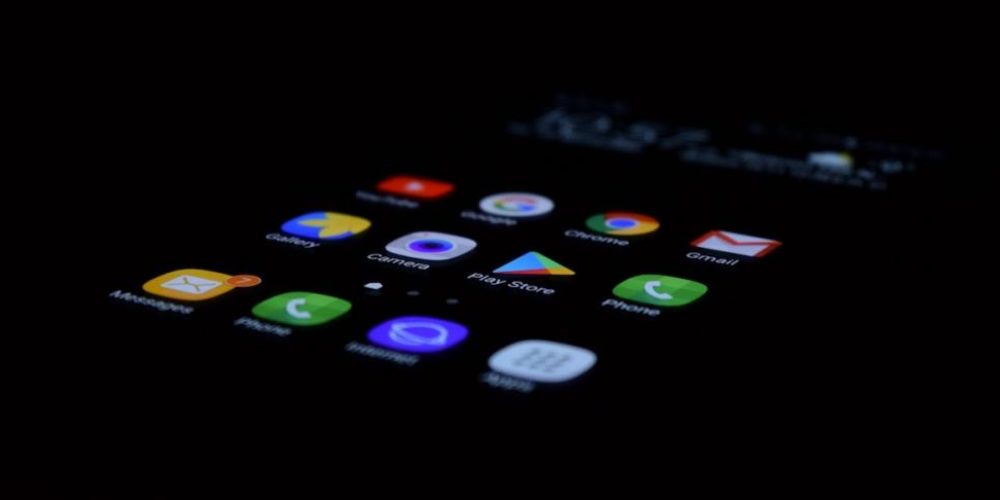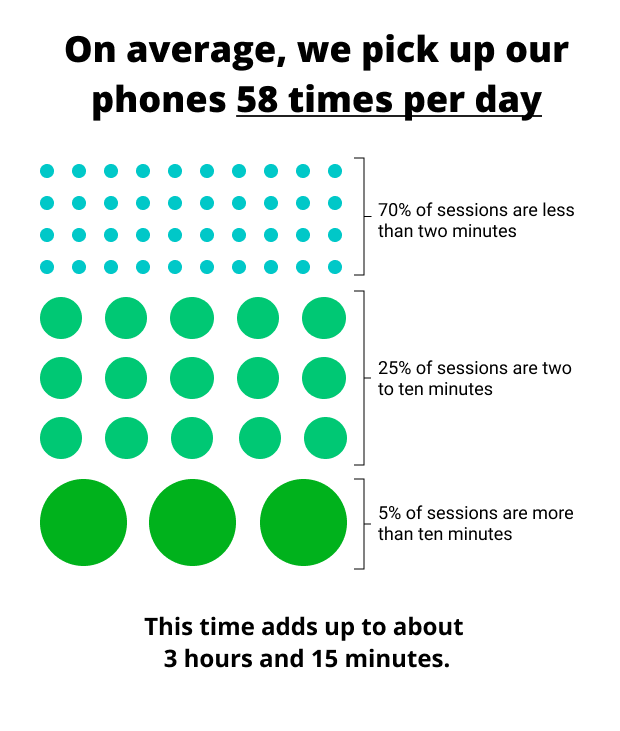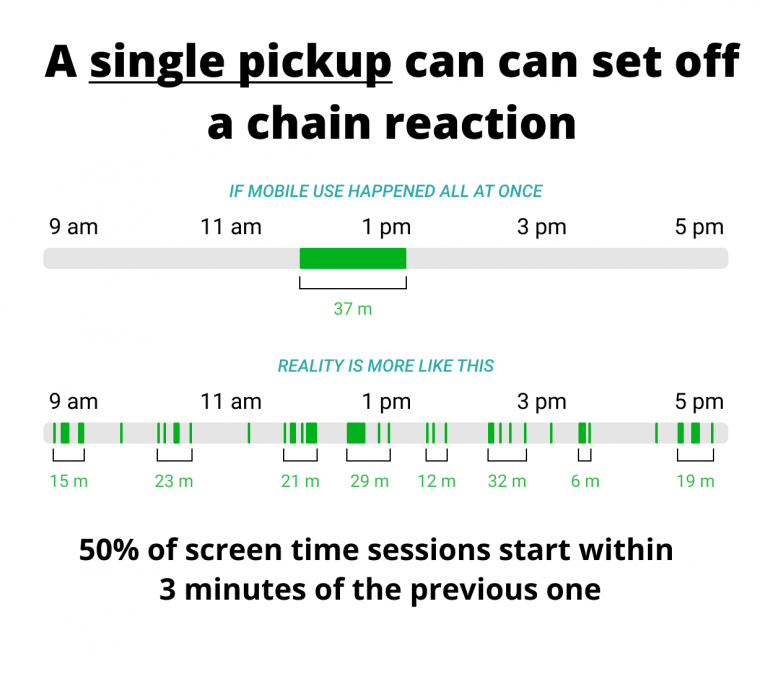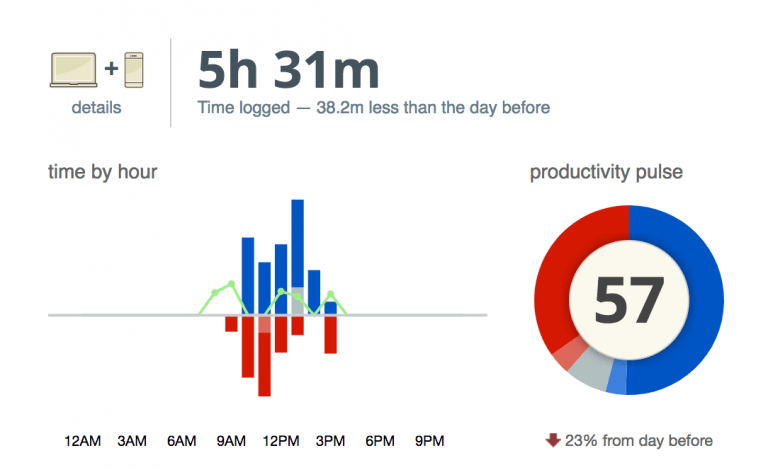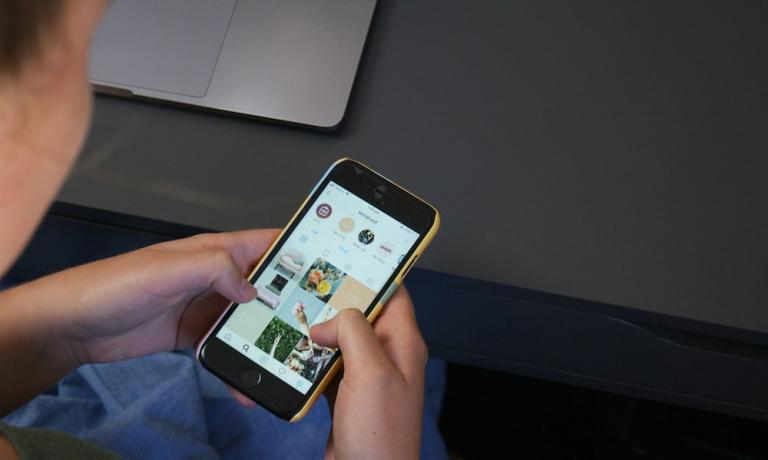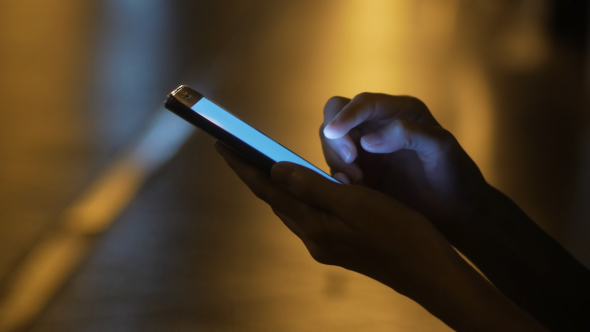It’s no secret that most of us spend too much time on our phones. And sure, it’s not all bad. Our phones are incredible tools for keeping us connecting, informed, and (sometimes) productive. However, study after study is starting to show that our screen time habits can have a pretty negative impact on our focus and attention. Especially during the workday.
If you’re like most people, your phone has become a modern-day safety blanket.
Feeling stressed about a project? Just check Instagram for a few minutes to get your mind off it.
Inbox getting out of control? You can always get to it after replying to some tweets.
But just the same as our relationship with communication tools like email and IM, the true impact of our screen time isn’t just about how much time we spend on our devices. It’s about how often we use them.
Research has consistently found that context switching kills our productivity, by slowing us down and making us feel rushed, overworked, and susceptible to burn out. If you want to do your best work, you need to have control over how your screen time affects the rest of your work. So, just how much screen time are we actually using during the workday?
On average, we spend 3 hours and 15 minutes a day on our phones
Let’s start with the high-level stats. When we looked at the data of 11,000 users who actively use the RescueTime app, we found that most people, on average, spend 3 hours and 15 minutes on our phones.
Now, that’s just an average. When we break these numbers down, we see that the top 20% of smartphone users have daily screen time in excess of 4.5 hours.
The top 20% of smartphone users spend more than 4.5 hours a day on their phones. Find out more in the Screen Time Stats Report. CLICK TO TWEET
And while you think you might spend more time browsing your phone during the weekend, that’s not the case. In fact, we found that most people spend slightly more time on their phones during the week than on weekends.
Most people check their phones 58 times a day (with 30 of those during working hours)
As we said earlier, it’s not just your total screen time that impacts your productivity, but how often you’re picking up your phone.
If you’re anything like me, you probably catch yourself opening your phone throughout the day—sometimes even without noticing what you’re doing.
And while a recent Deloitte survey found the average American checks their phone 47 times a day, our number was slightly higher. We found that, on average, users check their phones 58 times a day with 30 check-ins happening during working hours (9am–5pm).
And just how distracting are these check-ins?
Most people spend about 1 minute and 15 seconds on their phone each time they pick them up. This means we’re losing 37.5 minutes a day during working hours to our phones (at a minimum).
We lose at least 37.5 minutes of working time per day to just picking up our phones. Find out more in the Screen Time Stats Report. CLICK TO TWEET
Half of all phone pickups happen within 3 minutes of a previous one
Here’s where things start to get a little hairy. While you might think that a half hour or more of screen time during the workday isn’t an issue, there’s something deeper we need to dive into: Frequency of phone use.
As we said before, context switching can be incredibly disruptive to our productivity.
Back in 2004, researchers Victor M. González and Gloria Mark of UC Irvine found that on a typical day, most people spend just 3 minutes on a task before switching to something else. And this was before the first smartphones.
As you’d probably expect, most people use their phones in short bursts—sending a text or email and then picking it back up when they get a response. In fact, we found that 70% of screen time sessions are less than 2 minutes in length.
But while the sessions themselves are short in duration, they can set off a chain reaction of events that take over our days. Surprisingly, we found that 50% of screen time sessions start within 3 minutes of the previous one.
Picking up your phone throughout the day is as bad as multitasking
Now, why is this a big deal?
Let’s play out a common scenario: Let’s say you’re at work focusing on a project when all of a sudden BUZZ—a text from your partner.
Nothing urgent. But you respond to it anyways. Ok, good. Distraction avoided. Time to get back to work. But 2 minutes later, BUZZ—a follow-up question.
If this back and forth goes on for the next 20-30 minutes (or longer, depending on the delays between responses) how can you be expected to stay focused?
The truth is, you’re not.
Psychologists have found that even brief mental blocks created by shifting between tasks can cost as much as 40% of your productive time.
And when it comes to our phones especially, it’s not just the switches themselves that interrupt our day, but the expectation of being interrupted.
In fact, a recent study in the Journal of the Association for Consumer Research found that even the presence of a turned off smartphone lowered our cognitive performance. In other words, just having your phone around undercuts your ability to do good work.
Want to know how much time you’re spending on your phone (and set meaningful screen time goals?) Find out how RescueTime for iOS and Android can help.
To combat too much screen time, start by changing your defaults
These stats aren’t meant to be another rallying cry against our smartphones.
There’s no denying the devices we keep in our pockets are incredible tools. It’s an amazing feeling when they help us navigate an unfamiliar city, talk to our family and friends from across the planet, or teach us to unclog a sink.
Unfortunately, you don’t get those great features without the bad ones as well—the distracting, interrupting, more more more of social media, push notifications, and always-available entertainment.
If you want to take control of your screen time, keep your phones for their benefits, and mitigate the distracting features, there are a few simple methods you can try.
(For more, check out our roundup of our 6 Best Pieces of Advice on Building a Better relationship with your phone.)
1. Delete or log out of social apps
By far, the biggest time sucks on our phones are social apps like Facebook, Instagram, and Twitter. The issue with these apps is that they’re what Make Time author John Zeratsky calls “Infinity Pools”—the endless, pull-to-refresh content apps that you can “dip” back into at any time and find new content.
These apps are just too easy to spend minutes (or hours) on. Instead, try deleting them off your phone or logging out of them so there’s friction whenever you find yourself mindlessly trying to get in. (I did this with Instagram on my phone and instantly felt a sense of relief!)
2. Make a “Distraction free” home screen
Is the first thing you see on your phone’s home screen Infinity Pools and little red dots? If so, you’re setting yourself up for distraction. Instead, try moving all unnecessary or distracting apps off your home screen and to the 3rd or 4th one instead.
Keep the things that genuinely help you—maps, your camera, messages—but get rid of anything distracting.
3. Turn off notifications (or go into do-not-disturb mode while working)
Who decides when you use your phone? You, or it? In most cases, it controls the relationship. To flip that around, you need to get rid of all the things that grab your attention. Start by disabling notifications on anything that isn’t critical. Whenever a new app asks to show notifications, say “no.”
Finally, you might even want to go into do-not-disturb mode while you’re working to ensure messages and random buzzes don’t distract you (all your notifications will still be there, waiting for you, when you turn DND mode off).
As Paris Martineau writes in The Outline:
“Sure, the downside is I don’t answer texts and emails immediately, but the upside is I don’t answer texts and emails immediately.
“It’s fantastically relaxing and comes with the added bonus of giving your friends and loved ones the impression you’re doing something interesting or fulfilling with your life, rather than just scrolling through Twitter and not continually responding to the pressure of push notifications.”
These aren’t all the solutions to fixing your relationship with your phone. But they are a good place to start shifting who’s in control.
4. Push as much as possible to your laptop
Convenience has become one of the most important factors in guiding how we use our digital devices. Yet with convenience comes complacency.
To keep your digital time more meaningful, Digital Detangler founder, Pete Dunlap, suggests pushing as much of your actions to your laptop:
“Your laptop is usually closed while you are driving or eating with other people. While the smartphone tends to butt into those moments in ways that make us less safe and present.
“Also, the lack of a keyboard is a design choice demonstrating that smartphones are primarily media consumption devices—great at typing out snippets like tweets or hashtags on Instagram photos, poor at doing anything complex or meaningful.”
Not only are you only able to use your laptop in certain scenarios (rather than scroll aimlessly through your smartphone). But it can be much easier to understand and control your time spent on your laptop, using tools like:
- RescueTime: Get deep insights into how you spend your digital time. Set Goals and get real-time Alerts. And block distracting websites when you need to do work.
- ScrollStopper: Pete’s own Chrome extension that removes “infinity scroll” from your social media to help remind you not to get lost in it.
We rarely go for more than 2 hours without touching our phones
Our phones are always within arms reach. And that’s not going to change. In fact, according to our research, few of us go longer than 1 hour and 43 minutes during the day without touching our phones.
Screen time isn’t all bad. But when we give our phones free rein to poke us throughout the day, it goes from a useful tool to a total nuisance.

